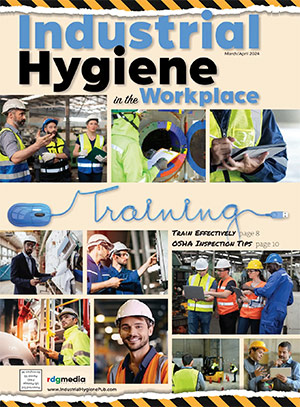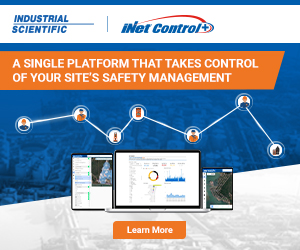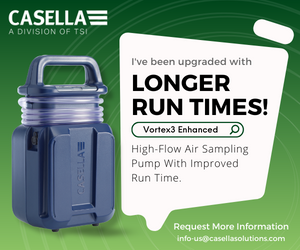For Safety’s Sake: Managing Industrial Dust and Fumes
By: Jon Ladwig, Contributor
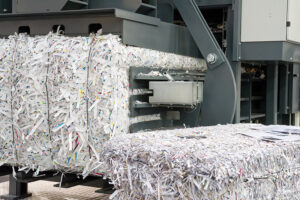
Industrial processes create airborne dust particles that pose a health risk to employees and a safety risk to facilities. (photo courtesy Camfil APC)
Many industrial manufacturing and processing applications produce dangerous airborne dust or fumes. Facility operators must be diligent in controlling these particles to ensure the health and safety of workers and to maintain regulatory compliance.
Dust consists of fine particles of dry, solid matter that are carried in the air and eventually settle on exposed surfaces. The airborne particles or dust clouds can irritate eyes and skin and damage the lungs. As dust settles on flat surfaces, it becomes a hazard that is often combustible, and it increases the risk of slips and falls. In addition, dust can be a highly combustible fuel source that can burn easily or, in the right conditions, explode upon contacting an ignition source.
Industrial dust is generated during a facility’s manufacturing or processing operations, such as cutting, drilling, grinding or sawing. Process dust can also come from materials, chemicals or ingredients used in the production process such as flour, sugar and pharmaceuticals.
Applications like welding, plasma cutting and laser cutting also produce tiny particles, generally referred to as fumes. Like dust, these fumes reduce indoor air quality and endanger workers. Fumes consist of tiny airborne dust particles that contain ingredients that can aggravate eyes and skin, and they can be toxic when swallowed or inhaled.
To maintain a clean and safe work environment, airborne dust and fumes must be captured before they harm workers or cause combustible dust explosions. It is best to convey the captured dust and fumes into a dust-collection system that gathers the dust and contains it in a safe way. After the dust is removed from the air, the clean air can often be safely returned indoors or exhausted outdoors.
Important Considerations for a Dust Management Plan
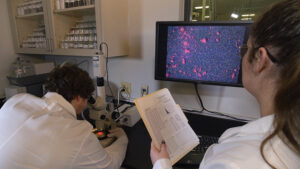
Dust analysis laboratory where particle characteristics are identified. (photo courtesy Camfil APC)
1. Conduct a Dust Hazard Analysis
Performing a dust hazard analysis (DHA) is the best way to evaluate your facility’s risk for employee exposure and is a required task, per National Fire Protection Association (NFPA) Standard 652, to determine if any of the dust you are generating is combustible.
Understand the dust you produce by:
- Conducting a dust analysis to identify characteristics of the particles to determine the best collection and filtration system
- Completing dust explosivity testing
- Having an industrial hygiene or environmental engineering assessment performed
OSHA’s General Duty Clause, Section 5(a)(1), stipulates that it’s an employer’s responsibility to identify and abate hazards in the workplace. OSHA also requires employers to keep records of these dusts, and it provides guidelines on hazard identification and assessment.
2. Test for Explosiveness & Flammability
NFPA standards 652 and 654 require a combustible DHA to assess risk and determine the necessary fire and explosion protection. Facilities producing combustible dust during their processes must demonstrate reasonable progress toward completion of the DHA each year before the deadline.
The first step is to determine whether your dust is explosive by sending a sample to a lab for an explosive dust test. If your test results are explosive, then your testing report should include the Kst and Pmax, which indicate the amount of pressure an explosion can generate and how fast it can travel. NFPA classifies dusts according to explosibility in terms of their Kst values and by type—organic or metal.
Kst is the normalized maximum rate of explosion pressure rise, measured in bar m/s. A bar is a metric unit of pressure, which is slightly less than the average atmospheric pressure on earth at sea level. Your dust-collection equipment supplier will need the Kst and Pmax values to correctly size explosion venting and suppression systems.
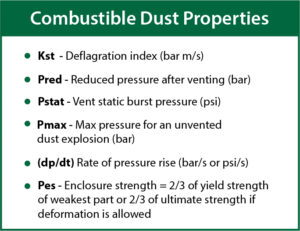

3. Assess Employee Exposure & Dust Hazards
An industrial hygiene assessment helps to identify and control harmful exposures to dusts. This assessment includes evaluating your facility to ensure you are meeting OSHA permissible exposure limits (PELs) for the dusts your processes produce.
Ask your dust-collection equipment supplier to recommend an industrial hygienist or environmental engineering company that is experienced in identifying dusts specific to your operation.
Dust Hazards Testing
It’s also important to analyze dust characteristics to determine the best dust-collection system design for your operation. The following dust characteristics are determined by bench-testing a sample of your dust:
- Particle size distribution
- Dust shape
- Bulk density
- Moisture level
- Abrasiveness
Be sure to look at whether your dust is a type that tends to generate static electricity. Those types of dusts can be ignition sources for dust explosions. Dust-collection equipment suppliers often can conduct dust testing and work with you to specify the best system and required filter media. Dust testing is an excellent tool to better understand the physical properties of your dust, which forms the basis for equipment selection. To create a complete picture of your operation, the testing laboratory should ask for detailed application data.
4. Create Air Quality Goals
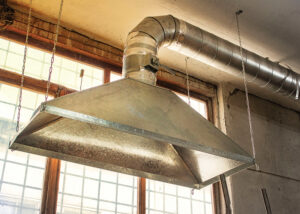
Dust collector hood to capture dust at the generation source. (photo courtesy Camfil APC)
Your dust management program should include air quality goals based on both of the following sources:
- Guidelines found in Industrial Ventilation: A Manual of Recommended Practice for Design from the American Conference of Governmental Industrial Hygienists (ACGIH)
- OSHA regulations regarding the PELs for applicable dusts, particularly where workers are at risk for long-term health effects
Review the results from your industrial hygiene assessment, OSHA guidelines, explosive dust testing and dust analysis to determine solutions to capture and contain dusts. Another important part of your assessment is listening to, observing and questioning your workers. They can let you know if current engineering controls are effectively managing dusts at the facility and suggest areas for improving processes and equipment.
If you are recirculating the cleaned air back into the facility, it must stay below OSHA PELs for contaminants. When exhausting the air outdoors, you are subject to EPA National Emission Standards for Hazardous Air Pollutants (NESHAP) Rule 6X and must perform an EPA Method 22 Fugitive Emissions test. The test is conducted using a visual determination of fugitive emissions from exhaust sources and is performed by a trained observer.
5. Method of Capturing Dust
An industrial dust-collector system designed specifically for your operation is a proven engineering control for hazardous airborne contaminants. There are three general methods for capturing dust using dust-collection systems:
-
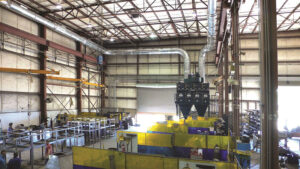
Indoor dust-collection system that recirculates filtered air. (photo courtesy Camfil APC)
Source Capture
These systems typically use flexible source capture arms, slotted dust hoods or smaller slotted hoods with side shields on a workbench operation.
- Enclosures and Canopies
Hoods are often used if the footprint area is less than 12 X 20ft. Curtains or walls may be added to the sides of a hood to create an enclosure, as long as they don’t interfere with workspace. Some applications use a full enclosure over and around the process area.
- Ambient Systems
You can filter all the air in a facility using one central system or multiple smaller collectors. Ambient systems are often favored for larger work areas involved in multiple operations, but they might require a bank of HEPA safety monitoring filters (also called secondary or after-filters). Secondary filters provide backup protection, particularly where air is returned indoors downstream of the collector. Since ambient systems don’t remove dust particles directly from the breathing zone, PPE might also be required.
6. Design a System that Minimizes Operating Costs
A safe dust-collection system can also be very cost-effective. A properly designed system will minimize energy usage and operating costs. For example, system zoning allows you to operate the collection system where it is needed, while other areas can be turned down or shut off.
Incorporating variable speed drives for fans on dust collectors saves energy. The variable speed drive produces a steady airflow because the system only runs the motor as needed to maintain the static pressure setpoint. Also, it automatically reacts to filter loading or movable applications. Having this feature increases reliability, extends filter life, reduces maintenance and saves energy.
Recirculating the filtered air is an ideal way to save energy and maximize return on investment. Flowing cleaned air from the collector back through the facility instead of venting it outdoors eliminates the cost of replacing that air. In addition, you can eliminate the complex EPA paperwork and monitoring procedures involved when dusts are exhausted outdoors.
It is recommended to use a secondary safety filter when recirculating into your facility to obtain the required OSHA PEL levels.
7. Consult with Peers and Your Local AHJ
Networking with peers is another way to discover processes, equipment and vendors to help manage airborne dust. Also, consult with professional associations and certification groups. Ask your authority having jurisdiction (AHJ), such as Factory Mutual or local fire marshals, for their safety guidelines.
When selecting a dust-collection system supplier, look for one that is experienced with your specific processes, as well as being knowledgeable about OSHA, NFPA and EPA requirements. The supplier also needs to have the technical resources to develop an engineered solution. It should offer a full range of equipment in order to give unbiased advice on the right type of system for your facility. Experienced suppliers also provide testing services and training.
Summing It Up
Managing dusts in manufacturing and processing facilities is necessary for the safety and well-being of employees and to achieve regulatory compliance. Conducting proper dust hazard analysis with industrial hygiene assessment, explosive dust testing and dust analysis will help you to develop a dust management plan. Incorporate components that provide flexibility, increase reliability, reduce maintenance and maximize energy savings.
A dust-collector system designed specifically for your operation and containing high-efficiency cartridge and secondary filters is an accepted and proven engineering control that filters hazardous, respirable particulates and makes indoor environments safer and healthier.
About the Author
Jon Ladwig is the Metal Processing Specialist for Camfil Air Pollution Control (APC). Camfil APC, a unit of the Sweden-based air filtration company Camfil, is an industry-leading global manufacturer of dust-, fume- and mist-collection equipment for challenging industrial applications, with production facilities around the world including the Americas, Europe and Southeast Asia. For information, contact 800-479-6801 or 870-933-8048; email filterman@camfil.com; or visit www.camfilapc.com.
Share on Socials!
Machinery Noise Control: The First Step
Comprehensive Combustible Dust Explosion Protection New methods of Explosion Pressure Relief: REMBE® TARGO-VENT
Gaseous Hydride Hazards & the High-Tech EV Revolution
Leaders in Industrial Hygiene
Council for Accreditation in Occupational Hearing Conservation (CAOHC)
Subscribe!
Sign up to receive our industry publications for FREE!



